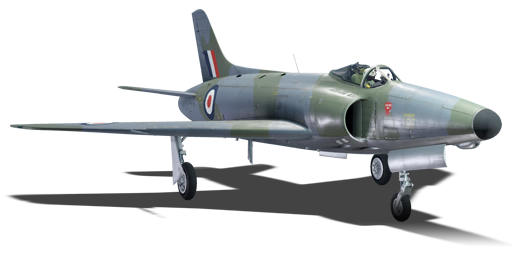



Following the failure of the Swift F.1, a number of upgrades were made, including the installation of afterburn-capable engines, structural modifications, and a longer nose to accommodate cameras and a more powerful radar. The variants culminated in the Swift F.7, notably the first and only Swift to be fitted with guided air-to-air missiles, namely the Fireflash. However, despite having resolved most of the issues plaguing the Swift line, the F.7 never entered service, having been made redundant by the Hawker Hunter, and the 14 built aircraft were relegated to training purposes and trialling of the Fireflash.
Introduced in Update 1.91 "Night Vision", the Swift F.7 builds upon the characteristics of the preceding F.1 variant, in particular with a new afterburning engine allowing the Swift to accelerate even faster. The beam-riding Fireflashes can also pose a new and unusual threat, as opponents are unlikely to be expecting an air-to-air missile capable of being launched in head-on engagements. The Swift F.7 continues to excel at catching enemies by surprise, and utilising its speed and energy retention to stay out of harm's way. However, it also maintains the F.1's poor manoeuvrability, which can make obtaining shooting solutions and dodging the increasingly common IR-guided missiles difficult without proper speed management.
flaps
flaps
flaps
brake
| Belt | Belt filling | Armor penetration (mm) at a distance: | |||||
|---|---|---|---|---|---|---|---|
| 10 m | 100 m | 500 m | 1000 m | 1500 m | 2000 m | ||
| AP/HEI-T | 37 | 34 | 22 | 13 | 8 | 5 | |
| AP/HEI-T/AP | 37 | 34 | 22 | 13 | 8 | 5 | |
| HEF-I/HEI-T | 4 | 4 | 4 | 4 | 4 | 4 | |
| AP/HEF-I | 37 | 34 | 22 | 13 | 8 | 5 | |












Flight performance | |
|---|---|
Survivability |
|---|
Weaponry | |
|---|---|